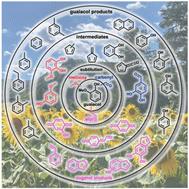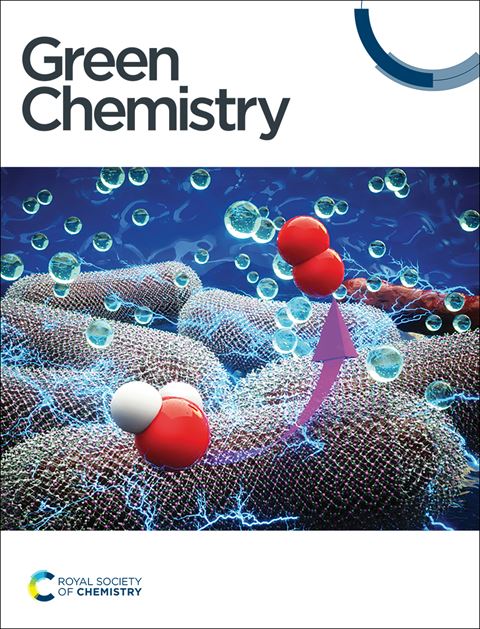Catalytic pyrolysis mechanism of lignin moieties driven by aldehyde, hydroxyl, methoxy, and allyl functionalization: the role of reactive quinone methide and ketene intermediates†
IF 9.2
1区 化学
Q1 CHEMISTRY, MULTIDISCIPLINARY
引用次数: 0
Abstract
The catalytic pyrolysis of guaiacol-based lignin monomers, vanillin, syringol, and eugenol over commercial HZSM-5 has been investigated using operando Photoelectron Photoion Coincidence (PEPICO) spectroscopy to unveil the reaction mechanism by detecting reactive intermediates, such as quinone methides and ketenes, and products. Vanillin shares the decomposition mechanism with guaiacol due to prompt and efficient decarbonylation, which allows us to control this reaction leading to a phenol selectivity increase by switching to a faujasite catalyst and decreasing the Si/Al ratio. Syringol first demethylates to 3-methoxycatechol, which mainly dehydroxylates to o- and m-guaiacol. Ketene formation channels over HZSM-5 are less important here than for guaiacol or vanillin, but product distribution remains similar. C3 addition to guaiacol yields eugenol, which shows a more complex product distribution upon catalytic pyrolysis. By analogies to monomers with simplified functionalization, namely allylbenzene, 4-allylcatechol, and 4-methylcatechol, the eugenol chemistry could be fully resolved. Previously postulated reactive semi-quinone intermediates are detected spectroscopically, and their involvement opens alternative pathways to condensation and phenol formation. Allyl groups, produced by dehydroxylation of the β-O-4 bond, may not only decompose via C1/C2/C3 loss, but also cyclize to indene and its derivatives over HZSM-5. This comparably high reactivity leads to an unselective branching of the chemistry and to a complex product distribution, which is difficult to control. Indenes and naphthalenes are also prototypical coke precursors efficiently deactivating the catalyst. We rely on these mechanistic insights to discuss strategies to fine-tune process conditions to increase the selectivities of desired products by enhancing either vanillin and guaiacol or supressing eugenol yields from native lignin.


木质素分子在醛、羟基、甲氧基和烯丙基官能化作用下的催化热解机理:反应性醌甲醚和酮中间体的作用。
我们使用操作光电子光电共振(PEPICO)光谱法研究了商用 HZSM-5 催化热解愈创木酚基木质素单体、香兰素、丁香酚和丁香酚的过程,通过检测反应中间产物(如醌甲酯和酮类)和产物,揭示了反应机理。香兰素与愈创木酚的分解机理相同,都是迅速而有效地发生脱羰基反应,因此我们可以通过改用 faujasite 催化剂和降低硅/铝比例来控制这一反应,从而提高苯酚的选择性。丁香酚首先脱甲基生成 3-甲氧基邻苯二酚,后者主要脱羟基生成邻愈创木酚和间愈创木酚。与愈创木酚或香兰素相比,HZSM-5 上的烯酮形成通道并不那么重要,但产品分布仍然相似。愈创木酚加入 C3 后生成丁香酚,丁香酚在催化热解过程中的产物分布更为复杂。通过与简化官能化的单体(即烯丙基苯、4-烯丙基邻苯二酚和 4-甲基邻苯二酚)进行类比,丁香酚的化学性质得以完全解析。之前推测的反应性半醌中间体在光谱学上被检测到,它们的参与开辟了缩合和苯酚形成的替代途径。由 β-O-4 键脱羟基生成的烯丙基不仅可以通过 C1/C2/C3 损失分解,还可以在 HZSM-5 上环化生成茚及其衍生物。这种相当高的反应活性导致化学反应的非选择性分支和复杂的产物分布,很难控制。茚和萘也是有效使催化剂失活的典型焦炭前体。我们根据这些机理见解来讨论微调工艺条件的策略,通过提高原生木质素中香兰素和愈创木酚的产量或抑制丁香酚的产量来提高所需产品的选择性。
本文章由计算机程序翻译,如有差异,请以英文原文为准。
求助全文
约1分钟内获得全文
求助全文
来源期刊

Green Chemistry
化学-化学综合
CiteScore
16.10
自引率
7.10%
发文量
677
审稿时长
1.4 months
期刊介绍:
Green Chemistry is a journal that provides a unique forum for the publication of innovative research on the development of alternative green and sustainable technologies. The scope of Green Chemistry is based on the definition proposed by Anastas and Warner (Green Chemistry: Theory and Practice, P T Anastas and J C Warner, Oxford University Press, Oxford, 1998), which defines green chemistry as the utilisation of a set of principles that reduces or eliminates the use or generation of hazardous substances in the design, manufacture and application of chemical products. Green Chemistry aims to reduce the environmental impact of the chemical enterprise by developing a technology base that is inherently non-toxic to living things and the environment. The journal welcomes submissions on all aspects of research relating to this endeavor and publishes original and significant cutting-edge research that is likely to be of wide general appeal. For a work to be published, it must present a significant advance in green chemistry, including a comparison with existing methods and a demonstration of advantages over those methods.
 求助内容:
求助内容: 应助结果提醒方式:
应助结果提醒方式:


